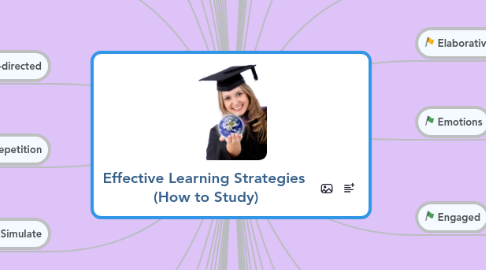
1. Resources
1.1. Blogs
1.1.1. Toni Krasnic
1.1.1.1. 5Ps of CLM
1.1.1.1.1. 1. Preview
1.1.1.1.2. 2. Participate
1.1.1.1.3. 3. Process
1.1.1.1.4. 4. Practice
1.1.1.1.5. 5. Produce
1.1.2. Cal Newport
1.1.3. Annie Murphy Paul
1.1.4. Scott H Young
1.2. Articles
1.2.1. Strengthening the Student Toolbox (Dunlosky)
1.2.2. Improving Students’ Learning With Effective Learning Techniques (Dunlosky et al.)
1.3. Books
2. Legend
2.1. Highly effective
2.1.1. Robust
2.1.2. Generalize widely
2.2. Moderately effective
2.2.1. Shows promise but insufficient evidence
2.2.2. Works for some people
2.3. Low effectiveness
2.3.1. Low utility
3. Visualize
3.1. Pictures, colors, cartoons
3.2. Diagrams, charts, graphs
3.3. Bizzare visualizations/associations
4. Write
4.1. Write down what you've learned
4.2. Writing challenges you to organize your thoughts
5. Verbalize
5.1. Condense data into key concepts
5.2. Translate to your own words
6. Videos
6.1. Supplement reading materials with videos
7. Think
7.1. While learning
7.2. About what you're learning
7.3. About how you're learning
8. Teach
8.1. You colleagues
8.2. Other students
9. Summarization
9.1. Condense text
9.2. Capture important ideas
10. Subconscious
10.1. Sleep on it
10.2. Revisit later
10.3. Thinking "to go"
11. Student-directed
11.1. You're in charge of your own learning
11.2. Responsibility
11.3. Control of your learning
12. Spaced repetition
12.1. See distributed practice
13. Simulate
13.1. Practice with new problems
13.2. Declarative knowledge (facts)
13.3. Procedural knowledge (process)
14. Self-explanation
14.1. Explaining how new information is related to known information
14.2. Explaining steps taken during problem solving
15. Review and reinforce
15.1. How much have you learned?
15.2. What needs additional work?
16. Retain and recall
16.1. Recall information
16.2. Recreate mind map
17. Rereading
17.1. Restudying material after initial reading
18. Reflect
18.1. Process information in your own way
18.2. What you know about what you know
18.3. How you learn
19. Practice testing
19.1. Self-testing
19.2. Practice tests
19.3. Practice recall
19.4. Helps with future retrieval
20. Paraphrase
20.1. Your own words
21. Organize
21.1. Structure information
21.2. Arrange and rearrange
22. Logical
22.1. Sound reasoning
22.2. Part makes sense in the whole
23. Mnemonics
23.1. Visuals
23.2. Connections
24. Keyword mnemonic
24.1. Keywords
24.2. Mental imagery
25. Key questions
25.1. Inquiry-based learning
25.2. Purposeful
26. Key concepts
26.1. What's important?
27. Meaningful
27.1. Does it make sense to you?
27.2. Learn from general to specific
27.2.1. Start with outline
27.2.2. Add details
28. Big picture
28.1. Overview
28.2. Details
29. Breakdown
29.1. Break skills into smart parts
29.2. Practice, measure, improve
30. Analogies
30.1. This is similar to that
31. Chunking
31.1. Grouping information
32. Concentrate
32.1. Stay focused
32.2. Pay attention
33. Active learning
33.1. Interact with information
34. Associate
34.1. Link new information to existing knowledge
35. Connect information
35.1. Connect the dots
35.2. How does it all connect?
35.3. Build new knowledge on existing knowledge
36. Connect with others
36.1. Interact with others students
36.2. Group work
36.3. Teachers
36.4. Parents
37. Cram
37.1. Studying the night before
38. Deliberate practice
38.1. Quality + Quantity
38.2. Highly structured
38.2.1. Improve performance
38.3. Requires
38.3.1. Focus
38.3.2. Effort
38.3.3. Time
38.4. Process
38.4.1. Motivated to improve performance
38.4.2. Build on existing knowledge
38.4.3. Immediate informative feedback on performance
38.4.4. Repeat until mastered
38.4.4.1. Not inherently enjoyable
39. Distributed practice
39.1. Spread out study sessions over time
39.2. Each subsequent phase reinforces the previous phase
39.3. Go back to what you don't understand
39.4. Don't cram
39.5. Longer intervals lead to longer retention
40. Elaborate
40.1. Work with extended information
40.2. Beyond class materials
41. Elaborative interrogation
41.1. Generate explanations
41.2. Why is this true?
42. Emotions
42.1. Heart
42.2. Feelings
43. Engaged
43.1. Interest
43.2. Curious
43.3. Critical thinking
44. Environment
44.1. Change study place
44.2. Slows down forgetting
45. Experience
45.1. Life is greatest teacher
45.2. Case studies
46. Explain
46.1. Discuss with others
46.2. In your own words
47. Feedback
47.1. See results of how you're learning
47.2. Adjust learning strategies based on feedback
48. Feynman Technique
48.1. 1. Explain idea as if teaching another student
48.2. 2. If stuck, go back to reference materials and relearn
48.3. 3. Explain idea again
48.4. 4. Explanations simple as possible
49. Filter
49.1. Choose important concepts
49.2. Eliminate the fluff
50. Flash cards
50.1. See practice testing
50.2. Flash cards
50.2.1. Quizlet
50.2.2. StudyBlue
50.2.3. FlashCardMachine
